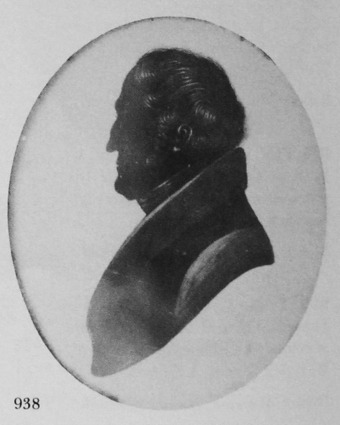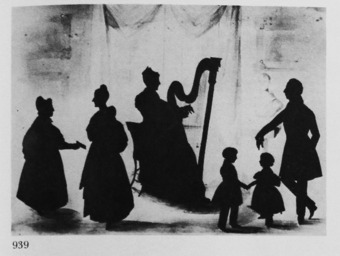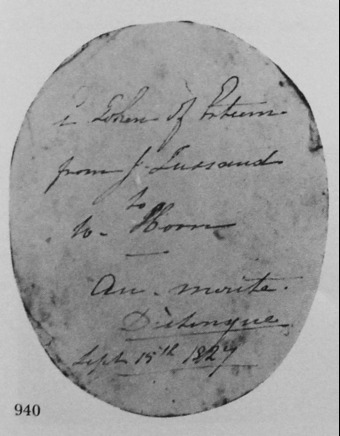Tussaud, Joseph (McKechnie Section 2)
Recorded by Jackson (The History of Silhouettes). Joseph Tussaud was the elder of the two sons of Madame Tussaud (née Marie Grosholz), the founder of the famous Waxworks Exhibition, and François Tussaud.
From the age of four Joseph Tussaud helped his mother with the Exhibition. I give below a list of the towns visited by Madame Tussaud and her son, after they had come to Britain, during the years 1815-28. In 1815 they visited Portsmouth. In the archives of Madame Tussaud's Exhibition in London there is a poster (dated, in ink, 5 December 1815) which was used to advertise the exhibition. It is 20 in. deep, and is headed 'Only for a short time, By Permission of the Right Worshipful the Mayor, just arrived from Plymouth Dock'. Below there is the Royal Coat of Arms, and then a description of the figures and other subjects to be shown at the exhibition. At the foot of this imposing poster there is a reference to profile
work by Joseph Tussaud: J. TUSSAUD most respectfully informs the Nobility, Gentry and the Public, that he has a Machine by which he takes PROFILE LIKENESSES, with the utmost Accuracy. price 2s. to 3s according to Style.'
This seems to be the first mention of Tussaud as a profilist. In 1815 he was nineteen years old. The next reference (which may have been an advertisement) is dated by Jackson to 1823, but she does not record where she saw it: 'Son of the great Madame Tussaud, Respectfully informs the Nobility, and Gentry and the Public in general that he has a Machine by which he takes Profile Likenesses. Price 2s to 7s. according to style. Biographical and descriptive sketches of the whole length compostion figures and other works of art forming the unrivalled collection of Madame Tussaud, etc.' This suggests that Tussaud had branched out into depicting some of the models in the exhibition, but it may only refer to sketches of the models which were advertised, and were obtainable at the exhibition, but were not necessarily by Tussaud.
Jackson also refers to an entry in Notes and Queries (6th Series, V), in which it was said that Tussaud sometimes mounted his portraits as groups and drew buildings and scenery as backgrounds.
Joseph Tussaud's work is advertised in the earliest extant catalogue (1819) of the Exhibition, and continued to be advertised until 1828. I give below the texts of two advertisements, published in two catalogues of the waxworks exhibition dated 1826 and 1828. Curiously, Tussaud's prices have been reduced in the latter catalogue, which also seems to be the last recorded mention of his work. The exact date of his death is not known; he died either in 1864 or in 1865.
The first of' the two advertisements, issued in Bury St Edmunds, reads as follows:
J. P. TUSSAUD
(SON OF MADAME T.)
Respectfully informs the Nobility, Gently, and the Public in general, that he has
A MACHINE
BY WHICH HE
TAKES PROFILE LIKENESSES,
PRICE 2s. to 7s., ACCORDING TO STYLE.
The second advertisement, issued in Penrith, reads as follows:
'Profile shades are the purest and most perfect resemblance
that can be obtained.' — LAVATER.
Profile Likenesses taken with a Physiognotrace,
By J. TUSSAUD,
AT THE EXHIBITION,
s. d.
In Bronze, usually charged 5 Shillings, 3 0
In Black Profile Shades, 1 6
Frames of the best description.
J. T. respectfully announces that he will attend every day for the above purpose, from 11 to 4; and hopes from the approbation that has hitherto attended his efforts to please, to meet with encouragement.
Specimens to be seen at the Rooms.
J. BROWN, PRINTER, PENRITH.
Joseph Tussaud married, and his wife bore him one son (who died unmarried) and two daughters. Surviving members of the family, in the direct line, are descended from Joseph's younger brother Francis. One of these descendants, Mr Angelo Tussaud, owns a silhouette of Madame Tussaud herself, taken by Alfred Hervé (see Section One), who, perhaps as a compliment to his sitter's Swiss origin, used his French title (Count de la Monniére) when signing the silhouette.
A group silhouette of Madame Tussaud with her family, by Joseph Tussaud, is discussed below. It does cause one to wonder whether a friendship existed between the Hervé and Tussaud families, who were both doubtless French-speaking. Not only does the profile of Madame Tussaud in the group closely resemble the profile by Alfred Hervé, but also Charles Hervé (see Section One) exhibited in 1835 a portrait of Joseph Tussaud at the Society of British Artists (from 138 Regent Street). Alfred Hervé was probably a little older than Joseph Tussaud; Charles Hervé may have been much of an age with Madame Tussaud.
The following list of towns visited by Madame Tussaud's Exhibition (accompanied by Joseph Tussaud) may assist in the identification of any profiles which may be discovered:
1815 Bath, Taunton, Plymouth, Portsmouth
1816 Salisbury, Newbury, Reading, London, Maidstone
1817 No records of visits; possibly the exhibition was in London
1818 Canterbury, Deal, Ipswich, Rochester, Bury St Edmunds, Cambridge
1819 Norwich, King's Lynn, Boston (Lincolnshire), Lincoln, Newark, Nottingham, Derby, Sheffield
1820 Sheffield, Wakefield, Leeds, Manchester
1821 Bolton, Wigan, Liverpool, Manchester
1822 Manchester
1823 Birmingham, Coventry, Cheltenham, Bristol
1824 Bath, Cirencester, Oxford, Northampton, Peterborough, Stamford, Cambridge, Colchester
1825 Colchester, Chelmsford, Yarmouth, Norwich, King's Lynn, Bury St Edmonds, Boston
1826 Boston, Louth, Gainsborough, Lincoln, Doncaster, Hull
1827 Leeds, Stockton, Durham, Sunderland, North Shields, Newcastle, Alnwick
1828 Edinburgh, Dumfries, Carlisle, Penrith, Lancaster, Preston
On his advertisements, Joseph Tussaud states that he paints profiles both in black and in the bronzed style. The first of my two illustrations is of a bronzed bust-length silhouette, dated 1827. The sitter, William Horne, was great-great-grandfather of the present owner, Miss Rose L. Lord. Horne is believed by his descendants to have been a sailor, which suggests that this profile might have been painted in a seaport, possibly in the north of England, where Tussaud was during 1827. This example is painted directly onto the card. Since the sitter's ear and his cravat are painted in gold, this must have been one of the more expensive bronzed profiles. The bronzing is fine, though not quite as finished as that of John Field, or even of Mrs Edward Smith (q.v.), another artist who excelled in this type of work. The bust-line is similar to that seen on the work of some other artists of the time. Unsigned work by Tussaud might be difficult to isolate. The bronzing on the cravat might be characteristic: many artists painted this either in plain black or in thinned black pigment.
The second illustrated example is the group of the Tussaud family (taken c. 1835-37). The original has been lost, and the work on this silhouette (which has been reproduced from a photograph which is now nearly forty years old) is difficult to assess. It is just possible that this group was cut, for the entry in Notes and Queries cited by Jackson states that Tussaud sometimes mounted his portraits as groups, and drew in the background scenery. This may well be an example of this type of work. Whether the figures in this group were first cut or not, they appear to be painted in shades of dark grey, with detail in black (possibly gum arabic, which was commonly used at the time). The style seems comparable with Alfred Hervé's; indeed, Madame Tussaud's pose is very similar to her pose in the full-length profile taken by Alfred Hervé, referred to above. Tussaud's brushwork was not quite as fine as Hervé's. What can be seen of the background of this group depicts the drawing-room which Madame Tussaud lived in during the 1830s.
The story of the photograph of this group is in itself of interest. In 1935 the photograph was given to Woodiwiss by John Theodore Tussaud, grandson of Madame Tussaud and son of Francis Tussaud. The original group silhouette was lost after John Theodore Tussaud's death, and in 1966 Woodiwiss, just before he died, wrote to Lady Chapman (the archivist of Madame Tussaud's Exhibition, London) saying that he had mislaid the photograph. It was only in 1971 that it was discovered among his effects and sent to me.
There is no evidence that Tussaud used a printed trade label. I have illustrated the inscription on the back of the profile of Horne; the text is as follows:
A Token of Esteem
from J. Tussaud
to W. Horne
Au merite
Distingué
Sept. 15th., 1827
Ills. 938-940
446 938

William Horne
Silhouette painted on card, bronzed
15 September1827
3 x 2½in./77 x 64mm.
Frame: papier mâché
Inscribed by Tussaud on the reverse (see text and 940).
By permission of Miss Rose L. Lord

Madame Tussaud and her family
Group silhouette painted on card
c. 1835-37
From left to right: Madame Tussaud; Rebecca Tussaud (née Smallpage), wife of Madame Tussaud’s younger son, Francis; Elizabeth (Betsy) Tussaud (née Babbington), wife of Joseph Tussaud; Francis Babbington Tussaud, son of Joseph and Elizabeth Tussaud, born 1829; Louisa Tussaud, daughter of Joseph and Elizabeth Tussaud, born c. 1831; Francis Tussaud.
From a photograph in the author’s collection, formerly in the collection of the late J. C. Woodiwiss

Inscription of Joseph Tussaud, from the silhouette illustrated in 938.
By courtesy of Miss Rose L. Lord
